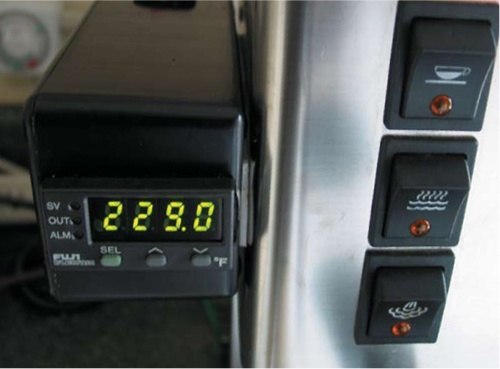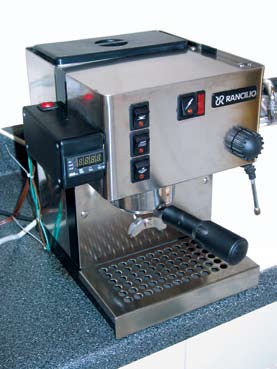Get consistent shots by adding precise temperature control to your espresso maker.
By John F. Murphy
The art of espresso making is fraught with many variables — coffee bean origin and blend, degree of roast, fineness and consistency of grind, tamping force and technique, and on and on and on. The temperature of the water used to brew the shot is one of the most important variables. In most espresso machines, the brew temperature is controlled by a wildly inaccurate thermostat.
However, control over the brew temperature is key to espresso quality. Different blends of espresso beans and different degrees of roast develop different flavors when brewed at different temperatures. Malabar Gold may taste sweet at a temperature that makes DSB taste sour. Control over the brew temp allows the skilled barista to coax the best flavor from each blend and each roast. In a stock Silvia espresso maker, relative brew temperature is roughly guestimated by “time surfing,” or pulling the shot a certain number of seconds after the stock thermostat turns on the heating element. Surfing does work, but it requires careful attention and lacks accuracy.
A better way is to use a PID controller. It’s easy to use (just set the desired temp and let the PID do its thing) and highly accurate, meaning the brew temperature of the next shot can be very nearly the same — if not exactly the same — as the last shot. And consistency from one shot of espresso to the next is the holy grail of espresso fanatics.
In simple terms (which is about all I can understand), a PID controller is a precise, computer-controlled thermostat. PID is an acronym for “Proportional, Derivative, Integral,” which has something to do with how the controller holds the boiler (in this application) at a precise temperature.
Here’s an analogy that explains how the PID works and why it is a good thing. Imagine you are driving your car down the street at 60mph. Ahead is an intersection controlled by a stop sign. If you continue to travel at 60mph until you reach the intersection and then slam on the brakes, your car is going to shoot past the stop sign before coming to rest. If, on the other hand, you gradually apply the brakes well in advance of the stop sign, you can come to a controlled stop right at the intersection. (This analogy is paraphrased from an explanation in the Fuji PXV3 manual.)
The stock brew thermostat in the Silvia is like the driver who slams on the brakes at the stop sign. The stock thermostat supplies full power to the boiler’s heating element until it reaches a certain temperature, and then cuts the power off completely. When the power is cut, the heating element continues to heat the boiler water for some seconds until the heating element cools off; this is like the car skidding through the intersection. On my Silvia, the stock thermostat turns off the heating element at around 220° F, but the water continues to heat up until it reaches about 238° F. This is called “overshoot.”
The PID controller is like the driver who gradually applies the brakes and slows down as he approaches the intersection. The PID controller turns the heating element on and off at one-second intervals. As the boiler approaches the desired temperature, the PID turns the heating element on for shorter intervals — like a driver braking harder the closer he gets to the stop sign (this is where the proportional, integral, and derivative calculations come in). Thus, the PID is able to hold the boiler at the desired temperature with very little overshoot. I usually see a 1° F or less overshoot with my PID’d Silvia. Compare that to the 18-degree overshoot with the stock thermostat.
Once the boiler is at the desired temperature, the PID cycles the heating element on and off at intervals calculated to maintain the boiler very close to that temperature. Mine fluctuates by about 1° F. The stock thermostat, by contrast, has a fluctuation of at least 40° F!

